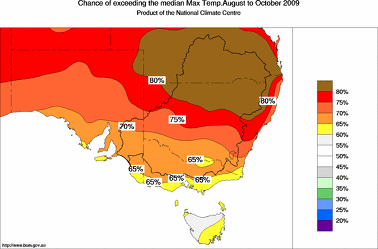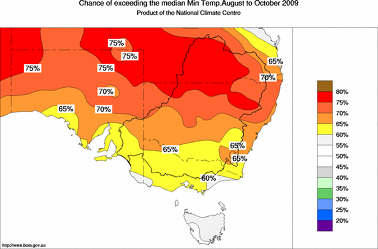|
The pattern of seasonal temperature odds across southeastern Australia is a result
of recent warm conditions in the Indian Ocean and a warming Pacific. The
Indian has had the greater effect, especially for minimum temperatures.
The chances of exceeding the median maximum temperature for August to October are
over 65% for most of southeast Australia, with odds above 80% in northern
NSW and a small area in northeastern SA. For Tasmania and southeastern
Victoria odds are between 55 and 65%. This means that for every ten years
with ocean patterns like the current, about six to eight years would be
expected to be warmer than average in terms of daytime temperatures averaged
over this period.
Outlook confidence is related to how consistently the Pacific and Indian
Oceans affect Australian temperatures. During August to October, history shows
this effect on maximum temperatures to be moderately consistent across most of
central and northern NSW and the northern half of SA (see background information).
However, over far southern NSW, Victoria, the southern half of South Australia
and most of Tasmania confidence is lower because the effect is only weakly
consistent.
The outlook for mean minimum temperatures over August-October is broadly similar,
with moderate to strong shifts in the odds favouring warmer than normal
conditions in most areas. Apart from Tasmania, the chance of a seasonal
average above the long-term median minimum temperature ranges from 60% in southern
Victoria to over 75% in far northern NSW. Thus, for every ten years with ocean
patterns like the current, about six to eight years would be expected to have
warmer than normal nights for this period, with about two to four being cooler.
History shows the oceans' effect on minimum temperatures for August to October to be
moderately consistent over most of NSW, and SA and the southeastern half of
Tasmania. However, over parts of northern and central SA, small parts of NSW,
all of Victoria and the northwestern half Tasmania, the influence is only
weakly to very weakly consistent.
| 










